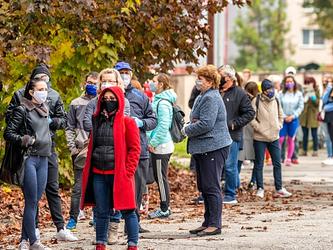Going for gold: Covid-19 and in-person surveys
From generating national statistics to providing informative data in person, research plays an incredibly powerful role in gold standard social surveys. This type of research was heavily disrupted by Covid-19 and a return to conducting interviews in person has proved to be both complex and challenging.
Kantar Public successfully completed a live pilot of a return to Covid-secure, in-home interviewing in August last year and since then has delivered almost 10,000 interviews with members of the public in the UK alone so far in 2022. Ben Collins is UK head of business excellence and, along with colleague Michelle Lewis, UK head of data and operations, has co-authored a presentation on the importance of in-home surveying.
He is candid about the challenges ahead: “The issues surrounding conducting in-person, especially in-home, research will continue. For some interviewers, uncertainty about what interviewing will now be like and their personal safety made them initially reluctant to come back. We know this is a challenge across the industry. But our interviewers, staff and clients demonstrated their resilience from the onset of the pandemic and continue to do so.”
Collins highlights how committed Kantar Public is when it comes to in-person surveying: “There are circumstances where research conducted by an interviewer, with that face-to-face interaction, is vital. In-person and in-home research, either alone or as part of a seamless mixed-method design, continues to play an incredibly powerful role in helping us understand people and shape public policy.”
It’s all in the mix
Rachel Abbott, director and joint head of social change at The Behavioural Architects, believes that a mixture of both in-person and remote research techniques best serves the projects on which her agency works. “It certainly feels easier to read the emotional energy behind what people are saying face to face, as well as to explore their context if we’re meeting in their everyday environment.
“But equally, remote interviewing can enable us to engage more participants in their own worlds and enhance accessibility – which is so important in our industry to increase diversity and inclusion.”
Jaala Gallagher, client director at barfly, a specialist consultancy that works with the global drinks industry, recalls that “there were certainly benefits to using Zoom for research during the pandemic, as it allowed us to continue working despite all the restrictions, and to do so in a cost-effective way.”
However, she points out that some essential cues may not be visible online. “It highlighted to us the richness you get from face-to-face interviews and the subtle nuances that can be missed on a virtual call. In-person interactions are much more likely to reveal those often-elusive insights, because sometimes it’s not just what we say that reveals how we feel – it’s how we say it.”
The face-to-face factor
Meanwhile, Tom Woodnutt, founder of Feeling Mutual, believes it depends on the context. “Ultimately, face-to-face focus groups have many advantages over groups by webcam. It’s easier to build rapport in person, explain stimulus, manage group dynamics and develop an intuitive understanding of people.”
However, he cautions that there is a lot more to online qualitative research than webcam focus groups. “For example, there’s asynchronous online and mobile methods, which means you get feedback from people across a few days, rather than in real-time and they enable a wider range of feedback, including screen recordings, mobile video, digital mappings, rankings and collages.
“I believe that on balance asynchronous online qual gives you more than face-to-face groups. That’s why we specialise in online and mobile qual, as we believe it is the gold standard for most qual research briefs.”
He outlines the benefits of asynchronous online and mobile methods as he sees them: “They encourage more emotional disclosure and stronger validity. These methods are much richer in colour, as they allow videos and photos, which makes the output more inspiring. And, critically, you get way more depth than with the equivalent face-to-face focus group.
“This is because only one person can speak at once in a live focus group, so in a typical two-hour session with eight people, you in fact get less than 15 minutes input per person. With asynchronous methods, however, you get more than eight times the input for the same incentive since everyone gives feedback in parallel at the same time.”
He concludes: “Participants’ answers can be given in private, so they are not influenced by what others say. Also, they answer from the comfort of their everyday environments, rather than artificial viewing facilities. This inspires more candid emotional disclosures and reduces the risk of participants posturing in front of others.”
Fed up with focus groups?
Focus groups have got a bad rap in recent years; Market Research Society (MRS) president Saj Arshad discussed their relevance in an interview with outgoing president Jan Gooding at the MRS conference in March.
“It’s all too easy to default to methodologies that have been used over a long time. We owe it to ourselves to take advantage of the full panoply of newer tools and methodologies now available”, he comments. “There is a role for them [focus groups], but I would definitely like to see them run alongside more quantitative, purer methods of research such as ethnographies and data mining.”
Brooke Ramsdale, managing director & country service line leader, qualitative & communities at Ipsos in the UK, agrees with Arshad that focus groups are only one part of the toolkit. “We would never recommend making big decisions based on focus groups alone”, she points out.
“At Ipsos we have every qual method at our disposal: long- term communities, qualitative social intelligence analytics, workshops, ideation sessions, curation, ethnography, in-the-moment qualitative mobile reaction, AR, VR, and indeed groups and depths – and let’s not forget the role of quant too.”
“While we moved away from groups when Covid hit, we still have briefs that really cry out for a face-to-face method. We had clients who paused key studies [during the pandemic] because focus groups are the best way to get at the nub of their problem.”
A combined approach will most likely be the way forward when it comes to formulating the new normal of insights research, but in-person interviews will always have their place. As Abbott at The Behavioural Architects observes: “It’s powerful, being there with people in person. After all, it’s not just what respondents say but what they leave out, and that’s easier to gauge in real life.
“Being in the participant’s world as a researcher gives you a fuller picture of what’s going on, including the chance to observe and pick up on things that they might not think to share, but which could be of vital importance.”
This article is from the July 2022 edition of Impact magazine.

We hope you enjoyed this article.
Research Live is published by MRS.
The Market Research Society (MRS) exists to promote and protect the research sector, showcasing how research delivers impact for businesses and government.
Members of MRS enjoy many benefits including tailoured policy guidance, discounts on training and conferences, and access to member-only content.
For example, there's an archive of winning case studies from over a decade of MRS Awards.
Find out more about the benefits of joining MRS here.














0 Comments